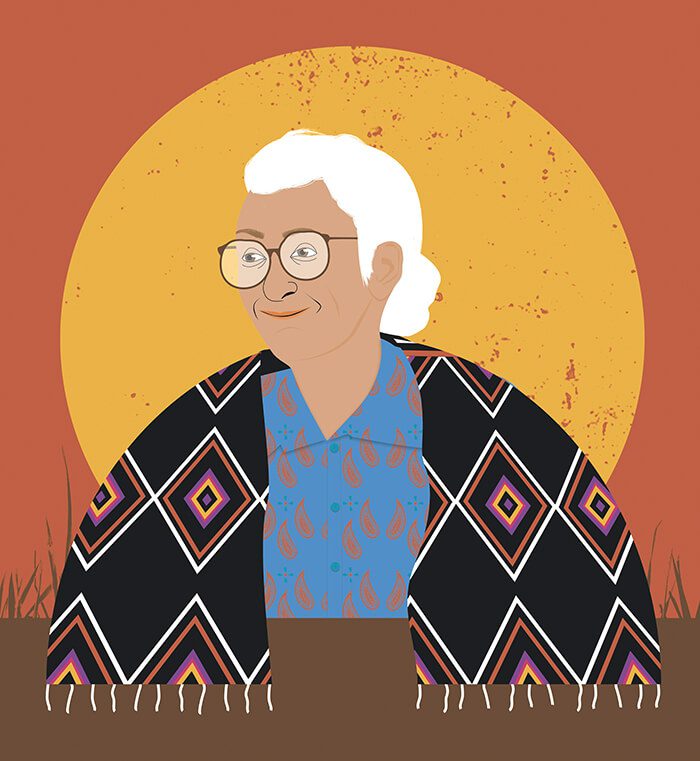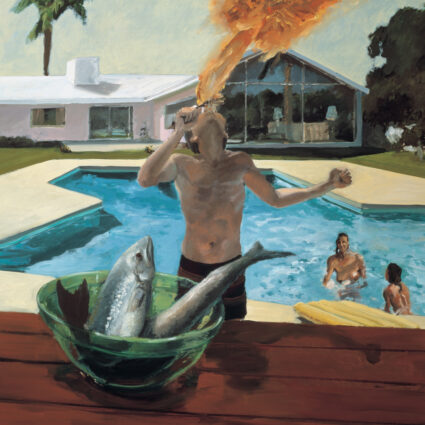
Name: Agueda Salazar Martínez
Born: Chamita, NM, 1898
Died: Mendanales, NM 2000
Role: weaver, farmer, badass matriarch
Known for: jerga style weaving, coarse texture incorporating rags and t-shirts
Quote: “Well, the only thing I can say is that as long as I can move, I will continue to weave.”
In a video taken in 1995, Agueda Martínez stands at her loom wearing a long floral dress, an apron, and a faded baseball cap with the logo of a local café. She works the threads quickly with both hands, tapping out a rhythm on the treadles below. She is 97 years old.
Doña Agueda, as she was known, had been weaving for eighty-five years when that video was taken. Born in Chamita in 1898, with early Spanish and Navajo roots, Doña Agueda learned to weave rag rugs from a neighbor when she was twelve. She continued to develop her style and approach after marrying Eusebio Martínez, a Chimayó weaver, and moving with him to Chimayó, where she studied with Lorenzo Trujillo, a prominent weaver in Rio Chiquito. Eusebio and Agueda eventually landed in Mendanales, raised ten children on their farm, and ran the Mendanales post office. They spent long evenings weaving by kerosene lamp to supplement their income with blanket sales to dealers in Santa Fe, Española, and Chimayó. Doña Agueda installed one of her three handmade treadle looms in the kitchen of their home so she could multitask. In her words, weaving was “a dance on the loom.”
Doña Agueda often used cotton cloth from found fabric ripped into strips for her work (T-shirts, rags), which she then wound on a spindle. From these scraps, she wove jergas: tapestries, rugs, and blankets with a coarse, colorful weave. She made her own dyes for her weavings from her thriving garden’s flowers and plants. Though her work reflects the influences of Saltillo, Rio Grande, Chimayó, and Navajo weaving styles, Agueda’s designs were truly her own. As she describes it, while “some people call this [pattern] with lines ‘Río Grande,’ some with more detail are called ‘Colonias,’ others are ‘Chimayó,’ and others ‘Mexican,’” she didn’t feel a need to label her work. “Mexican or American—call it what you want… I don’t call my [weavings] anything. I put my initials on it, and it’s mine.” Eventually, Doña Agueda’s weavings were so well known that she began to sell them to collectors out of her home, no longer needing to work with dealers in town.
From these scraps, she wove jergas: tapestries, rugs, and blankets with a coarse, colorful weave. She made her own dyes for her weavings from her thriving garden’s flowers and plants.
In the 1960s and ’70s, Doña Agueda participated in the Home Education and Livelihood Programs (HELP) in Hernández and Abiquiu, New Mexico, teaching dozens of Hispanic women how to weave and helping to keep the tradition alive. She won a 1975 New Mexico Governor’s award, was the first honoree of the Feria Artesana in Albuquerque in 1980, was the first Hispanic honoree for outstanding achievement in the visual arts selected by the National Women’s Caucus for Art in 1993, and was the subject of an Academy Award–winning documentary, Agueda Martínez, Our People Our Country, in 1977. Her piece Tapestry Weave Rag Jerga was acquired by the Smithsonian and featured on the official poster for the Smithsonian’s 1992 Festival of American Folklife.
Raising her daughters to weave as soon as they were tall enough to stand at the loom, Doña Agueda created a uniquely female line of weavers in what is otherwise a largely male history of Hispanic weaving in Northern New Mexico, dominated by the Ortegas and the Trujillos. Her daughter, Eppie, went on to win a 1985 National Heritage Fellowship from the NEA, and her granddaughters continue the tradition in New Mexico and in Colorado. Her daughter, Cordelia Coronado, opened La Lanzadera (The Shuttle), a weaving studio in Mendanales that she ran with her daughters Marcela and Teresa, and daughter-in-law Linda. The shop also housed the Mendanales post office, which stayed in the family.
For more on Hispanic weaving, see Helen Lucero’s Hispanic Weavers of Northern New Mexico: Three Families, UNM Southwest Hispanic Research Institute, 1994. bit.ly/hispanicweaversnnm.



